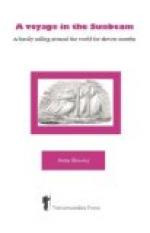Nishni Hongangi is one of the largest and finest temples we have yet seen, even in spite of a large portion having been destroyed by the disastrous fire of 1864. The gates are splendidly ornamented, with carved chrysanthemum flowers. The centre temple is very fine, and is surrounded by smaller rooms, all decorated by the best Japanese artists of about two hundred years ago. Notice had been sent that the English Minister was coming with a party of friends, and everything had accordingly been prepared for our reception. In some places they had even put down carpets, to obviate the necessity of our having to take off our boots. The Abbot was out, which I much regretted, for he belongs to the Montos, the most advanced sect of Buddhism, and has more than once remarked to English visitors that he thought their own principles were so enlightened that they were paving the way for a higher form of religion, in the shape of Christianity—rather a startling confession to come from the lips of a Buddhist priest.
After spending a long time among the paintings, wood-carvings, lacquers, bronzes, and gardens, we left the temple, and crossed several court-yards, before the main street was reached. Then, after a short walk, we came to another beautiful garden, laid out like a miniature park, with lakes, bridges, rocks, streams, canals, pavilions, &c. All these surround a house built by the celebrated Tycoon, Tako Sama, in the fifteenth century. Here, again, everything was prepared for our reception. Fires were lighted, flowers arranged, carpets laid down, and fruit and cakes placed in readiness, with hibatchis to warm each and all of us. We went all over the house, which differs little from a Japanese house of the present day, except that a higher style of art was employed in its construction and decoration.
From here we went to quite another quarter of the city to see what was formerly the Tycoon’s palace, now used as a sort of police office. It is built on the same plan of three enclosures as all the yashgis, though on a very different scale from the one at Tokio. There, the Tycoon reigns in undisturbed sovereignty. Here, he appears as a humble servant of his rightful master—really his prisoner. The late Tycoon, after the last battle, fought at this place, fled to his castle at Osaka, where, though he might have held out for an indefinite period, he preferred to surrender. Two of his Ministers came to him and represented that he must not only think of himself, but of the party who supported the Shogunate, and that as he had betrayed them by false hopes he had no choice but to perform Hara-kiru. This he refused to do, although they set him the example; and he is now living as a private individual on an estate in the country, not far from Tokio, where he amuses himself with hunting, shooting, and fishing. It is said that it is possible he may one day join the ministry of the present Mikado.
From the Tycoon’s palace we drove to the ‘Toshio,’ or court quarter of the town, where the Mikado and all his relatives live, in palaces, surrounded by large gardens, enclosed in whitewashed walls. We saw the whole of Tako Sama’s household furniture and wearing apparel, the celebrated swords of Yoritiome, called the ‘knee-cutter’ and the ‘beard-cutter,’ from their wonderful sharpness, and many other interesting objects.




